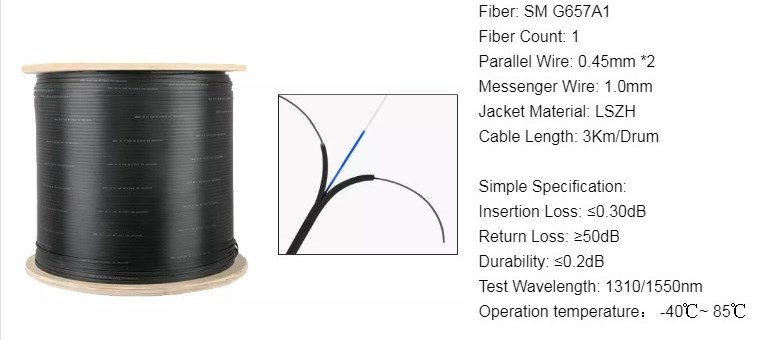FTTH (Fiber to the home) drop cable, the outer skin is generally black and white, the diameter is relatively small, and the flexibility is good; the cross section is 8-shaped, the reinforcing member is located at the center of the two circles, and the metal or non-metal structure can be used, and the optical fiber is located at the geometric center of the 8-shaped shape. The fiber inside the cable is mostly G.657A2 small bending radius fiber, which can be laid at a bending radius of 20mm. It is suitable for entering the house by pipe or distribution openly. The unique 8-shaped structure of the drop cable can realize the field end in the shortest time.
FTTH drop cable is a new type of fiber-optic cable. It is a butterfly-shaped cable. Because it is small in size and light in weight, it is suitable for the application of Fiber to the Home. It can be cut according to the distance of the site, increased the efficiency of construction.
FTTH fiber drop cables with FRP, KFRP, metal or non-metal strength members that designed for high-capacity indoor/outdoor FTTH networks.
Drop cable, as an important part of FTTH network, forms the final external link between the subscriber and the feeder cable. Choosing the right FTTH drop cable termination or interconnect solution will directly affect network reliability, operational flexibility and the economics of FTTH deployment. So between the two cable termination methods
FTTH fiber drop, as previously mentioned, are located on the subscriber end to connect the terminal of a distribution cable to a subscriber’s premises. They are typically small diameter, low fiber count cables with limited unsupported span lengths, which can be installed aerially, underground or buried. As it is used in outdoor, drop cable shall have a minimum pull strength of 1335 Newton’s according to the industry standard. Fiber optic drop cables are available in many different types. The three most commonly used fiber drop cables include flat drop cable, figure-8 aerial drop cable and round drop cable.

 汉信
汉信

